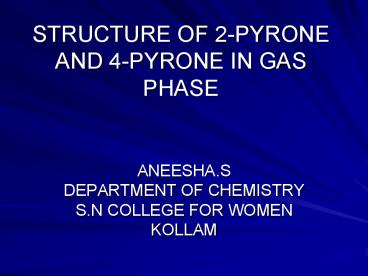STRUCTURE OF 2PYRONE AND 4PYRONE IN GAS PHASE - PowerPoint PPT Presentation
1 / 17
Title:
STRUCTURE OF 2PYRONE AND 4PYRONE IN GAS PHASE
Description:
In 2-pyrone, two of the bond angles showed large deviation from the experimental ... J.S. Fairlamb, Lester R. Morrison, Julia M. Dickinson, Feng Julu and Jan peter ... – PowerPoint PPT presentation
Number of Views:106
Avg rating:3.0/5.0
Title: STRUCTURE OF 2PYRONE AND 4PYRONE IN GAS PHASE
1
STRUCTURE OF 2-PYRONE AND 4-PYRONE IN GAS PHASE
- ANEESHA.S
- DEPARTMENT OF CHEMISTRY
- S.N COLLEGE FOR WOMEN
- KOLLAM
2
Computational chemistry is the application of
computer based models to the simulation of
chemical processes and the computation of
chemical properties. The development of various
software packages has facilitated the wide-spread
use of computational chemistry.
3
- Computing the geometry of a molecule is one of
the most basic functions of a computational
chemistry program. - The present investigation deals with the
estimation of the molecular structure of pyrones
in the gas phase using density functional theory.
4
Pyrones are keto derivatives of pyrans. They
exist in two isomeric forms
2-pyrone 4-pyrone
Pyrone subunit is found in natural products like
flavones and chromones which show interesting
biological effects.
5
- Methodology
- Software package used GAMESS (General Atomic
and Molecular Electronic Structure System) - Molecular geometry Specified using Z-matrix and
viewed using Molden graphic program. - Density functional theory Beckes 3-parameter
exchange with Lee, Yang and Parrs correlation
functional (B3LYP) is used. - Basis set used is aug-cc-pVDZ.
6
Results and discussion Optimized geometry of
pyrones in gas phase
2-pyrone
4-pyrone
7
Table ICalculated and experimental bond length
of 2-pyrone in gas phase
8
Table 2Calculated and experimental bond angles
of 2-pyrone in gas phase
9
Table 3Calculated and experimental bond length
of 4-pyrone in gas phase
10
Table 4Calculated and experimental bond angles
of 4-pyrone in gas phase
11
Table 5Dipole moments of 2-pyrone and 4- pyrone
in gas phase
12
Optimized geometry of 2-pyrone in the gas phase
showing the dipole moment vector
Optimized geometry of 4-pyrone in the gas phase
showing the dipole moment vector
13
- The calculated bond lengths and bond angles of
4-pyrone agree well with the experimental values.
- In 2-pyrone, two of the bond angles showed large
deviation from the experimental values. - The calculated dipole moments agree with the
experimental values.
14
REFERENCE
- Sir Derck Barton F.R.S Comprehensive Organic
Chemistry- The synthesis and reaction of organic
compound, Vol 4, 1960 - Morrison and Boyd,Organic Chemistry,Pearson
Education, Singapore, 6th edn, 2005. - Jan. J.S. Fairlamb, Lester R. Morrison, Julia M.
Dickinson, FengJulu and Jan peter
SchmidtBioinorganic and Medicinal Chemistry, Vol
12, 4285 -4299 ,2004 - Gulcan Ozturk, Dilck Demir Erol, Mutlu Dilsiz
Aytemir and Tayfun Uzbay, European Journal of
Medicinal Chemistry, Vol 37 ,829 -834, 2002. - Ganguly.A.K, Kaur.S, Mahata. P.K, Biswas. D,
Pramaunik B.N and Chan TM, Tetrahedron letters
Vol46,4119-4121, 2005
15
- 6. David Young, Computational chemistry, John
Wiley and Sons, London,2001. - 7. http//www.msg.ameslab.gov/GAMESS/GAMESS.
html. - 8. Ira N. Levine, Quantum Chemistry, Prentice
Hall of India, 4th edn, 2001 - Anderson,J.M Mathematics for Quantum Chemistry,
Benjamin, New York, 1966. - 10. Atkins,P.W., Molecular Quantum Mechanics, 2nd
edn, Oxford University Press, New York, 1983. - 11. Mulliken, R.S and Ermler,W.C Polyatomic
molecules, Academic Press, New York, 1981. - 12. Hehre, W.J, Radom. L, Schleyer. P.V.R. and
Pople J.A, Ab initio Molecular,Orbital Theory,
Wiley, New York,1986.
16
- 13. Slater, J.C, Quantum Theory of Atomic
Structure, Vols. I and II, Mc Graw
- Hill, New York, 1960. - 14. Wilson.S,Electron Correlation in Molecules,
Oxford University Press, New York, 1984. - 15. Hurley.A.C, Electron Correlation in Small
Molecules, Academic Press, London ,1976 - 16. Parr. R.G, Yang.W, Density-Functional Theory
of Atoms and Molecules, Oxford, 1989. - 17. Ratujczak.H,Orville-Thomas W.J, Redshaw.M,
Molecular Interactions, vol.3, John Wiley and
Sons, New York., 1982. - 18. Piyush K.Shukla, Sonia Ralhan and Ray N.K,
Indian.J. Chem, Vol 42A, 7-10, 2003. - 19. Macdonald J.N, Mackay S.A, Tyler J.K, Cox A.P
and Ewart. I.C, J. chem. Soc, Faraday Trans, 2,
77, 79, 1981 - Huang H.H, Tan S.F and Tjia T.H, J. hetero Chem,
13, 609,1976.
17
Acknowledgement Dr.Reena Ravindran, Lecturer
(Senior Scale), Department of Chemistry, S.N
College for Women, Kollam. Prof.(Dr). K.R
Srivathsan, Director, IIITM-K , Tecknopark
Campus, Tvpm. Prof.(Dr). M.S Gopinathan, Emeritus
Professor, IIITM-K Dr.T.K Manojkumar, Assistant
Professor, IIITM-K































